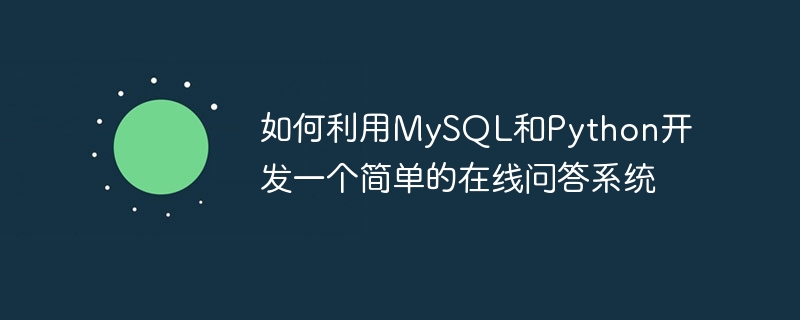Heim >Datenbank >MySQL-Tutorial >So entwickeln Sie ein einfaches Online-Frage- und Antwortsystem mit MySQL und Python
So entwickeln Sie ein einfaches Online-Frage- und Antwortsystem mit MySQL und Python
- WBOYWBOYWBOYWBOYWBOYWBOYWBOYWBOYWBOYWBOYWBOYWBOYWBOriginal
- 2023-09-20 14:34:491239Durchsuche

So entwickeln Sie ein einfaches Online-Frage- und Antwortsystem mit MySQL und Python
近年来,随着互联网的迅速发展,智能化技术逐渐广泛应用于各个领域。在线问答系统作为人机交互的重要手段之一,被越来越多的人所关注和使用。本文将介绍So entwickeln Sie ein einfaches Online-Frage- und Antwortsystem mit MySQL und Python,并提供具体的代码示例。
一、环境配置
在开发之前,我们需要进行一些环境配置。首先,需要安装MySQL数据库并创建一个数据库用于存储问答信息。其次,需要安装Python的MySQL库,用于连接和操作MySQL数据库。最后,我们还需要安装Python的Flask库,用于开发Web应用。
二、数据库设计
在开始编写代码之前,我们需要设计一个合适的数据库结构来存储问答信息。一个简单的问答系统至少包含两个表:一个用于存储问题信息,一个用于存储回答信息。下面是一个简化的数据库结构设计示例:
-
问题表(questions):
- id:问题ID
- title:问题标题
- content:问题内容
- create_time:问题创建时间
-
回答表(answers):
- id:回答ID
- question_id:问题ID
- content:回答内容
- create_time:回答创建时间
三、代码实现
接下来,我们开始编写代码实现一个简单的在线问答系统。首先,我们需要导入必要的库并进行数据库连接:
import mysql.connector
from flask import Flask, request, jsonify
app = Flask(__name__)
# 连接MySQL数据库
db = mysql.connector.connect(
host="localhost",
user="root",
password="123456",
database="qa_system"
)然后,我们创建一个用于获取问题列表的接口:
@app.route("/questions", methods=["GET"])
def get_questions():
cursor = db.cursor()
cursor.execute("SELECT * FROM questions")
questions = cursor.fetchall()
results = []
for row in questions:
question = {
"id": row[0],
"title": row[1],
"content": row[2],
"create_time": row[3]
}
results.append(question)
return jsonify(results)接下来,我们创建一个用于发布问题的接口:
@app.route("/questions", methods=["POST"])
def create_question():
data = request.json
title = data["title"]
content = data["content"]
cursor = db.cursor()
cursor.execute("INSERT INTO questions (title, content) VALUES (%s, %s)", (title, content))
db.commit()
return jsonify({"message": "Question created"})最后,我们创建一个用于获取指定问题的回答列表的接口:
@app.route("/questions/<int:question_id>/answers", methods=["GET"])
def get_answers(question_id):
cursor = db.cursor()
cursor.execute("SELECT * FROM answers WHERE question_id = %s", (question_id,))
answers = cursor.fetchall()
results = []
for row in answers:
answer = {
"id": row[0],
"question_id": row[1],
"content": row[2],
"create_time": row[3]
}
results.append(answer)
return jsonify(results)四、运行测试
编写完代码后,我们可以运行测试来验证系统是否正常工作。首先,我们需要启动Flask应用:
if __name__ == "__main__":
app.run()然后,我们可以使用Postman等工具来测试我们创建的接口。例如,可以使用GET方法请求/questions接口获取问题列表,使用POST方法请求/questions接口发布问题,使用GET方法请求/questions/<question_id>/answers</question_id>接口获取指定问题的回答列表。
通过以上步骤,我们就成功地利用MySQL和Python开发了一个简单的在线问答系统。
总结
本文介绍了So entwickeln Sie ein einfaches Online-Frage- und Antwortsystem mit MySQL und Python,并提供了具体的代码示例。当然,这只是一个简单的示例,实际的在线问答系统还有很多功能和细节需要考虑和完善。希望本文对于初次接触在线问答系统开发的人们能有所帮助,可以作为一个起点进行更复杂和完善的开发工作。
Das obige ist der detaillierte Inhalt vonSo entwickeln Sie ein einfaches Online-Frage- und Antwortsystem mit MySQL und Python. Für weitere Informationen folgen Sie bitte anderen verwandten Artikeln auf der PHP chinesischen Website!

